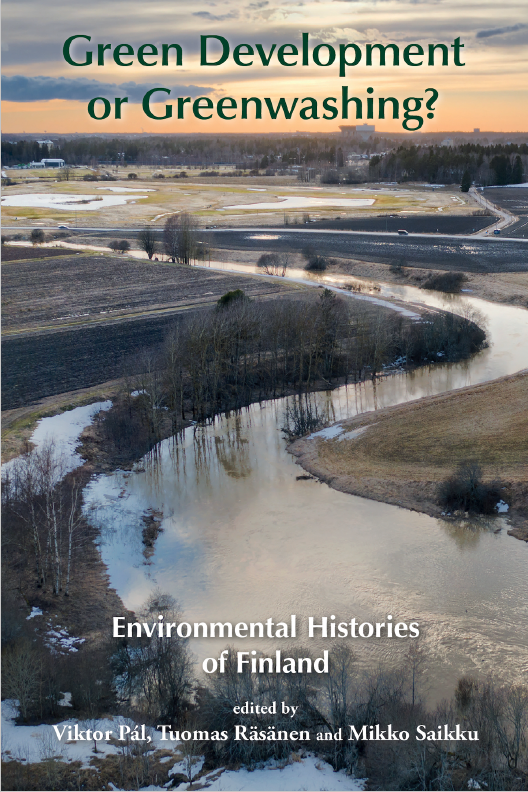Green Development or Greenwashing?
Environmental Histories of Finland
Viktor Pál, Tuomas Räsänen and Mikko Saikku (eds)
‘This fine volume has found a good balance between pointing to what’s right while avoiding the pitfalls of brute environmental iconoclasm. It serves as a valuable contribution to understanding Finland’s environmental policies and practices.’
Peder Anker, H-Net

Finland has often been labelled a ‘green superpower’, lauded as one of the world’s cleanest and greenest countries. Nordic countries in general have tended to be idealised as ‘pristine and green’, in contrast to the rest of the rapidly contaminating world where the race for markets and profits has enormously accelerated consumption, imposing on the environment an alarming level of extraction and commerce, and a wide array of new and old forms of pollution.
Environmental historians, however, can perceive that the reputed ‘greenness’ of the Nordic countries is partly an illusion. Authors in this volume argue that Finland, similarly to Denmark, Norway and Sweden, has evolved into a green superpower at the cost of considerable environmental problems. Ironically, Finland’s current leading position in sustainable development has been built on the heavy use of natural resources and by sacrificing ecosystem health.
This volume thus seeks to acquaint the reader with many stories of long-lasting negative environmental impacts in and around Finland: old-growth forests have been replaced by intensive forest farming for lumber and pulp industries; most wetlands have been drained for agriculture, forest cultivation and peat extraction; wild animal populations have been decimated; and Finland today is confined to the south and west by arguably the most polluted sea in the world.
There are lessons for the future to be learnt from Finland’s tendency to rest on the laurels of a positive environmental reputation built at least in part on myth. In the twenty-first century, the world badly needs less greenwashing and a truer commitment to green-ness.
THE EDITORS
Viktor Pál is a Hungarian environmental historian, an associate professor at the University of Tampere and the University of Ostrava, and a visiting researcher at the University of Helsinki. He is the author of Technology and the Environment in State-socialist Hungary: An Economic History (Palgrave Macmillan, 2017) and with Stephen Brain has co-edited the collection of essays, Environmentalism under Authoritarian Regimes. Myth, Propaganda, Reality (Routledge, 2019).
Tuomas Räsänen works as an associate professor of environmental history at the University of Eastern Finland. His research interests include the history of human-wild animal relationship, the history of Finnish environmentalism and the Baltic Sea marine environmental history.
Mikko Saikku is the McDonnell Douglas Professor of American Studies at the University of Helsinki. He is the author or editor of several internationally noted academic articles, collections and books, including This Delta, This Land: An Environmental History of the Yazoo-Mississippi Delta (University of Georgia Press, 2005) and An Unfamiliar America: Essays in American Studies (Routledge, 2021). He serves as Director of the Helsinki Environmental Humanities Hub.
TABLE OF CONTENTS
Contributor Biographies
Chapter 1. Introduction to the Environmental Histories of Finland
Viktor Pál, Tuomas Räsänen, Mikko Saikku
Section 1. Ideas and the Human Construction of the Environment
Chapter 2. Knowledge on Trees and Forests – Finnish Forest Research from the Nineteenth to the Twentieth Century
Jaana Laine
Chapter 3. ‘Reaching Maturity’ or ‘Selling Out’? The Idea of Green Growth in Finnish Green Party Environmental Discourses 1988–1995
Risto-Matti Matero
Chapter 4. The Changing Status of Birch Trees in the Finnish Forests. From the Seventeenth to the Twentieth Century
Seija A. Niemi
Chapter 5. Trash Food? Fish as Food in Finnish Society between the 1870s and the 1990s
Matti Hannikainen
Section 2. Contested and Colonised Spaces
Chapter 6. Cultural Nature in Mid-Lappish Reindeer Herding Communities
Maria Lähteenmäki, Oona Ilmolahti, Outi Manninen and Sari Stark
Chapter 7. Sami Frames in the Planning and Management of Nature Protection Areas in Historical Perspective – Environmental Non-conflict in Inari
Jukka Nyyssönen
Chapter 8. Wolves and the Finnish Wilderness: Changing Forests and the Proper Place for Wolves in Twentieth Century Finland
Heta Lähdesmäki
Chapter 9. All Quiet on the Eastern Front? The Finnish Army and Wildlife during WWII
Mauri Soikkanen and Simo Laakkonen
Section 3. Altering the Environment
Chapter 10. From Stale Air to Toxic: Concerns About Urban Air in Finland
Janne Mäkiranta
Chapter 11. From Eradication Campaigns to Care Protection: Finnish Endangered Animals in the Twentieth Century
Tuomas Räsänen
Open Access through the support of a collective of the authors’ institutions.
Publication date, October 2023
ISBN 978-1-912186-76-1 (PB) £32
e-ISBN 978-1-912186-77-8 (Open Access)
